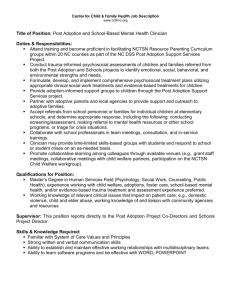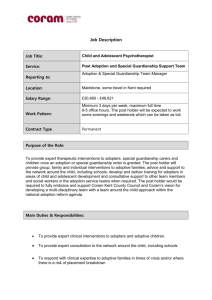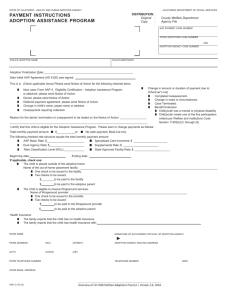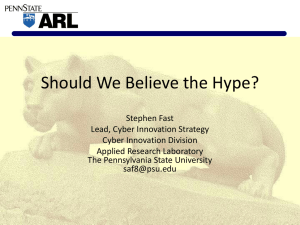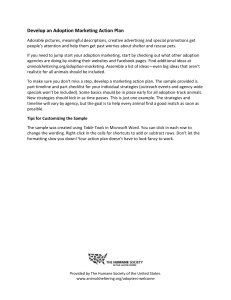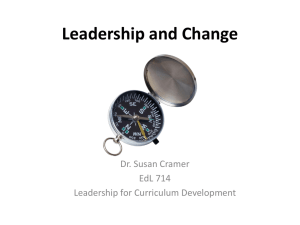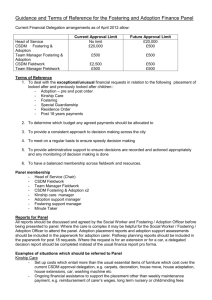Annual Report 2013 – 14 Recruiting and
advertisement
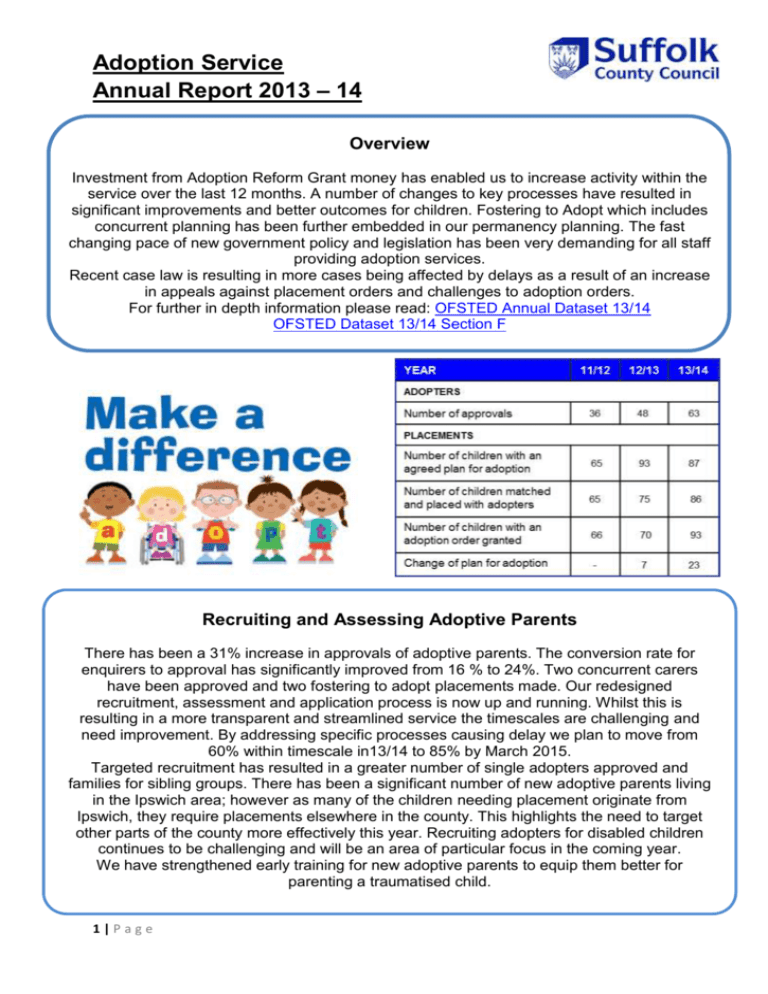
Adoption Service Annual Report 2013 – 14 Overview Investment from Adoption Reform Grant money has enabled us to increase activity within the service over the last 12 months. A number of changes to key processes have resulted in significant improvements and better outcomes for children. Fostering to Adopt which includes concurrent planning has been further embedded in our permanency planning. The fast changing pace of new government policy and legislation has been very demanding for all staff providing adoption services. Recent case law is resulting in more cases being affected by delays as a result of an increase in appeals against placement orders and challenges to adoption orders. For further in depth information please read: OFSTED Annual Dataset 13/14 OFSTED Dataset 13/14 Section F Recruiting and Assessing Adoptive Parents There has been a 31% increase in approvals of adoptive parents. The conversion rate for enquirers to approval has significantly improved from 16 % to 24%. Two concurrent carers have been approved and two fostering to adopt placements made. Our redesigned recruitment, assessment and application process is now up and running. Whilst this is resulting in a more transparent and streamlined service the timescales are challenging and need improvement. By addressing specific processes causing delay we plan to move from 60% within timescale in13/14 to 85% by March 2015. Targeted recruitment has resulted in a greater number of single adopters approved and families for sibling groups. There has been a significant number of new adoptive parents living in the Ipswich area; however as many of the children needing placement originate from Ipswich, they require placements elsewhere in the county. This highlights the need to target other parts of the county more effectively this year. Recruiting adopters for disabled children continues to be challenging and will be an area of particular focus in the coming year. We have strengthened early training for new adoptive parents to equip them better for parenting a traumatised child. 1|Page Matching and Placement The number of children matched and placed this year has risen in line with the increase in plans for adoption in 2012/13. A new planning and referral service has resulted in better planning at an earlier stage. Use of profiling events both internally and within the Consortium has resulted in 8 Suffolk children with complex needs being placed with new families. 23 of the 86 children matched were placed with out of county carers. We anticipate that this will reduce further in 2014/15 as our number of in-house approvals have gone up. 93 children were adopted this year. The proportion of children leaving care through adoption orders has risen to 27%. This compares with 13% nationally. We believe our high performance is due to robust early decision making. A case audit is being undertaken to test this. Disruptions of children placed for adoption have remained low at 2%. In 19 cases a plan for adoption changed before the final court hearing; 5 became subject of a Residence Order, 5 Special Guardianship Order’s, 4 Permanent Fostering and 5 returned home (1 on a Care Order) Timescales Our time scales for the child's journey from coming into care to placement in their new family are good and have further improved this year. Timescales for children who have been adopted in 2013/14 at one particular stage of the process had not improved; the adoption of 2 older sibling groups with highly complex needs have impacted significantly on these figures. These children are in our hardest to place group who would otherwise remain in care. A scorecard action plan with ambitious targets has been developed to ensure we focus on key areas to improve on timeliness. A number of key changes in practise were embedded in 2013-14 and early indications for timeliness in Q1 of 2014/15 show significant improvement to an average of 133 days for the 29 children matched: a figure well within the expected D of E timescales. Post Adoption Support – Families, Children & Adults During 2013-2014, the team has seen an increase in number and complexity of children referred to them. 63 families were referred which included 15 who were previously known to the service. 48 of these families received a package of support. Previously we have seen referrals peaking at key developmental stages. This remains the case for boys but referrals in relation to girls span all age groups. . Through training for staff members, utilising their skills and joint work with our CAMHS services access to local therapeutic services has improved for adoptive families. The team coordinates and supports a total of 1082 Letterbox Agreements (indirect contact with birth families) throughout the year. 720 requests for social work input have been made in 2013-2014 involving a range of contact issues. The impact of social networking sites such as Face book has been huge on adoptive families and birth family members. As a result unplanned reunifications are happening more frequently and at times placing vulnerable adopted children at significant risk. 111 adopted adults and birth relative have sought information, counselling and support when seeking information about their history within their birth family. This includes reunions between adopted adults and their birth family members. An increase is seen in these referrals when the topic is covered by the media such as TV programmes. 2|Page Panel Vice-Chairs’ Report Lyndsay Davidson joined us as Independent Permanence Panel Chair at the end of April. She has replaced Jane Held who left in December 2013 to concentrate on other work. Jane brought to her Panel responsibilities considerable energy, rigour, emotional intelligence and interpersonal skills; we wish her well for the future. The Vice Chairs kept the ‘show on the road’ during the interregnum. The Panel Advisor and Administrative Team were painstaking in supporting us while continuing to ensure paperwork arrived in good time and the minutes maintained the very high standard we have come to expect. We welcome new members this year as social work, independent and county councillor representatives. Panel members have matured and learnt together across the years, so it is refreshing to welcome ‘new blood’ and be stimulated by fresh perspectives on our work. Like all professional people, Panel members are expected to undertake regular training to ensure they have the necessary knowledge, skill and expertise for the role. This year we have benefitted from development sessions on a range of topics. . Panel Business Meetings have been held regularly, proving a valuable forum to discuss national and local developments. Panels have met regularly throughout the year and considered an increased number of adopter applications; the ‘matching’ workload has included children placed under Fostering to Adopt or Concurrency arrangements and those influenced by Activity Days and Presenting Children Events. It has been encouraging to see the positive impact of these innovations. As we learn more of the importance of robust support plans to placement success, so we have focussed on strengthening these where necessary and encouraging new parents to consider these as part of the placement plan rather than last resorts when all else has failed. Panel has been very pleased to welcome a number of children in person to give their views and ensure these are properly considered in the assessment of their parents as prospective adopters; or permanent fostering approvals. Others have submitted drawings or written comments. These are invaluable opportunities to capture ‘in real time’ young people’s feelings and perspectives and well worth the extra planning and time to accommodate them sensitively. We hope to have even more of this direct ‘voice of the child’ contribution in the year ahead. We look forward to developing further with Lyndsay ably guiding us from the ‘chair’. Linda James, Anne Peppitt and Barry Darch, Permanence Panel Vice-Chairs. 3|Page Plans for Adoption 93 plans for adoption were agreed by the Agency Decision-Maker between April 2013 and March 2014. With the process established, we have ensured that children’s social workers have been able to submit timely agreed plans to the Court. Of the plans for adoption considered the following background characteristics have been evident (There may be more than 1 characteristic per family) Birthparents background issues Plans for adoption Drug use by parents 41 Alcohol use by parents 32 Birth parent a ‘Looked After Child’ themselves, previously or currently 22 An abusive relationship with current partner 37 Mental health difficulties 21 Diagnosed learning disability 11 Diagnosed personality disorder 4 Significant criminal convictions 8 Diagnosis of depression 28 Experienced abuse and/or neglect in their own childhood Previous child adopted or have another child with a plan for adoption 45 16 Priorities for 2014 – 2015 Reducing timescales for approving adopters and placing children Analysis of trends in care planning for young children Increasing approvals of adopters for children with complex needs Developing Fostering to Adopt placements Review and redesign of adoption and permanence support team Working with partners in the region to improve performance and meet gaps in services 4|Page
